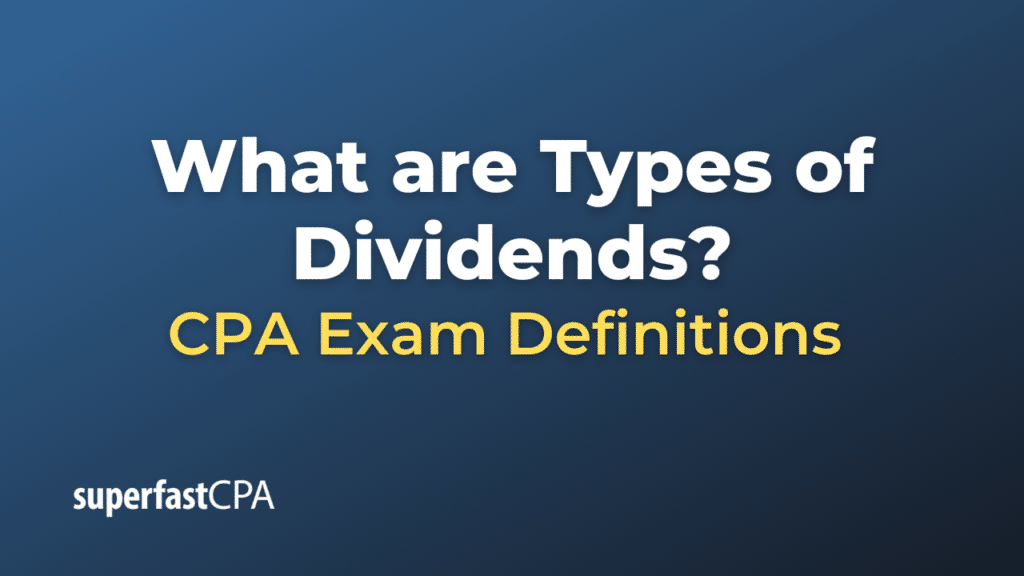Types of Dividends
Dividends represent a portion of a company’s profits that are distributed to its shareholders. The method and form of this distribution can vary. Here are the main types of dividends:
- Cash Dividends:
- This is the most common form of dividend. Companies distribute earnings to shareholders in cash, typically via a bank transfer or a check.
- Example: A company may declare a cash dividend of $0.50 per share, so a shareholder with 100 shares would receive $50.
- Stock or Scrip Dividends:
- Instead of cash, companies issue additional shares to the current shareholders.
- Example: A 5% stock dividend would grant the shareholder an additional five shares for every 100 shares they own.
- Property Dividends:
- Rather than cash or additional stock, companies might distribute property, which could include physical goods, real estate, or even shares from a subsidiary.
- Example: A company might distribute free samples of a new product to its shareholders.
- Special Dividends:
- A one-time dividend that a company might decide to distribute to shareholders after particularly good performance or upon the sale of a business segment or assets.
- Example: Following a lucrative business sale, a company might distribute a portion of the sales proceeds to shareholders as a special dividend.
- Interim Dividends:
- These are dividends distributed before a company’s annual general meeting (AGM) and the finalization of its annual financial statements.
- Example: A company with strong half-year profits might distribute interim dividends before the fiscal year ends.
- Final Dividends:
- Declared and paid after a company’s AGM and based on the finalized annual financial statements.
- Example: After finalizing its profits for the year, a company might announce final dividends in addition to or instead of any interim dividends already paid.
- Liquidating Dividends:
- Distributed to shareholders when a company is in the process of liquidation or winding up. It represents a return of capital rather than a profit distribution.
- Example: If a company decides to cease operations and sell off its assets, after settling all obligations, it might distribute the remaining funds to shareholders as liquidating dividends.
- Preferred Dividends:
- Dividends that are issued to the holders of preferred stock before any dividends are paid to common stockholders. Preferred dividends can be fixed or set as a percentage.
- Example: If a company has both preferred and common shareholders and declares dividends, preferred shareholders would receive their dividends first, and any remaining distributable profit would then go to common shareholders.
It’s important for investors to understand the type of dividends being offered and the company’s dividend policy when considering an investment, as dividends can represent a significant portion of an investor’s total return over time.
Example of Types of Dividends
Let’s use a fictional company named “TechGlow Inc.” to illustrate different types of dividends in action.
Scenario: “TechGlow Inc.” is a technology company that has had varied financial performance over the past few years. It has both common and preferred shareholders.
1. Cash Dividends:
- In a year of good profits, “TechGlow Inc.” declares a cash dividend of $1.20 per share. A shareholder who owns 500 shares receives $600 in cash.
2. Stock or Scrip Dividends :
- To conserve cash for an upcoming project, the company issues a 10% stock dividend instead of cash. A shareholder with 500 shares now receives an additional 50 shares.
3. Property Dividends:
- “TechGlow Inc.” has launched a new line of tech gadgets. As a promotional move, they distribute one gadget to every shareholder as a property dividend.
4. Special Dividends:
- After selling a patent for $2 million, the company decides to distribute a portion of this windfall to its shareholders. They declare a special dividend of $0.50 per share.
5. Interim Dividends:
- Six months into the fiscal year, with strong half-year profits, the company distributes an interim dividend of $0.40 per share.
6. Final Dividends:
- At the end of the fiscal year, after finalizing its annual profits and holding its AGM, “TechGlow Inc.” declares a final dividend of $0.80 per share.
7. Liquidating Dividends:
- Though not a scenario any company hopes for, if “TechGlow Inc.” were to wind up its operations, after clearing its debts, it would distribute the remaining assets to shareholders as liquidating dividends.
8. Preferred Dividends:
- TechGlow Inc.” has issued preferred shares with a fixed dividend rate of 5% annually. If each preferred share has a par value of $100, each share would receive $5 before any dividends are distributed to common shareholders.
Over the years, depending on the company’s financial health, strategy, and obligations to different types of shareholders, “TechGlow Inc.” uses various forms of dividends to reward its shareholders and meet its operational objectives. Each type of dividend carries specific implications for the shareholders and offers insights into the company’s financial management and priorities.














